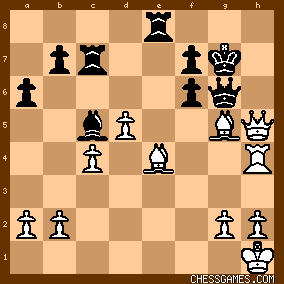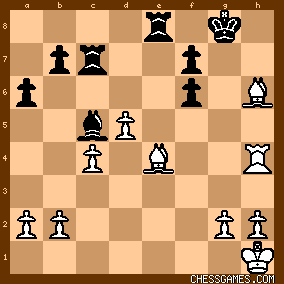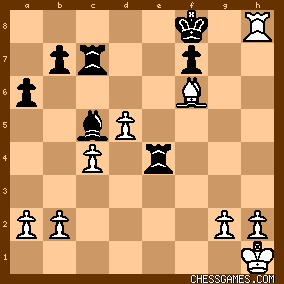|
< Earlier Kibitzing · PAGE 3 OF 4 ·
Later Kibitzing> |
| Sep-11-19 | | Fish55: <NM JRousselle> That looks like a faster mate. |
|
| Sep-11-19 | | ndg2: Black shouldn't have played this newfangled c5 stuff. It's bad for the center. |
|
| Sep-11-19 | | ndg2: On a more serious note: 11..Rc8 feels strange. Plus it prevents Qc8 in the final combo. |
|
| Sep-11-19 | | agb2002: White has the bishop pair for a bishop and a knight. Black threatens Nxh5.
The pawn on g7 is overburdened. Therefore, 26.Rxf6 gxf6 (26... e4 27.Bxe4 doesn't seem to improve anything for Black) 27.Bxh6: A) 27... Qg8 28.Bg5+ and mate next.
B) 27... Qe7 28.Bg5+ Kg7(8) 29.Qh7+ Kf8 30.Qh8#. C) 27... Qd6 28.Bf8+ Kg8 29.Qh6 (better than 29.Bxd6) 29... Qxf8 30.Qh7#. D) 27... Qd8 28.Bf8+ like D.
E) 27... Qe8 28.Bf8+ like D. |
|
| Sep-11-19 | | saturn2: I saw 26. Rxf6 gxf6 27. Bxh6..
27..Qg8 28. Bf8+ or
27..Qe8 28. Bg5+ Kg7 29. Qh7+ Kf8 30. Bxf6
27..Qd8 28. Qxf7 |
|
| Sep-11-19 | | patzer2: Hard to say exactly where Black lost this game. Passive play in the opening and throughout the game conceded White a strong advantage in center control, space and development. White didn't over press, but took whatever Black gave up to gradually increase the pressure in the center and against the weak King side castled position. Before long, Black drifted into a technically lost position. And after 23...Nd7? 24. Bd3 +- (+4.21 @ 32 ply, Stockfish 10), White's position became overpowering. Instead, 23...Be7 ± to +- (+2.31 @ 25 ply, Stockfish 10) might have provided Black a few practical drawing chances. For a Black improvement, I'd start with the opening and toss the passive 7...d6?! 8. 0-0 ± (+1.16 @ 30 ply, Stockfish 10). Instead, our Opening Explorer indicates Black has had much more success with the active, popular moves 7...Bb4 = (+0.16 @ 30 ply, Stockfish 10) as in Black's win in Naiditsch vs V Artemiev, 2017 or 7...b6 = to ⩲ (+0.25 @ 30 ply, Stockfish 10) as in the draw in M Muzychuk vs B Adhiban, 2019. |
|
| Sep-11-19 | | Autoreparaturwerkbau: Black could throw much more struggle with <27...♕g7!>

click for larger viewMake no mistake, black is still losing by all means but white's winning line <28.♖f1 e4 29.♗xe4 ♖c7 30.♖f4 ♖e8>

click for larger view<31.♖h4 ♕g6 32.♗g5+ ♔g7>

click for larger view<33.♕h6+ ♕xh6 34.♗xh6+ ♔g8>

click for larger view<35.♖g4+ ♔h8 36.♗g7+ ♔g8>

click for larger view<37.♗xf6+ ♔f8 38.♖h4 ♖xe4 39.♖h8#>

click for larger viewhas gotten downright tricky due to Black's persistent backrank mate threat until final move + elaborate setting up of final ♗+♖ blow. |
|
| Sep-11-19 | | malt: Seen 26.R:f6 g6
(26...gf6 27.B:h6 Kg8 28.Qg4+ Kh8 29.B:f8 )
27.B:g6 Qg7 28.B:h7 Q:f6 29.B:g5+ Kg8 30.B:f6 fg6 31.Q:g6+ |
|
| Sep-11-19 | | Cheapo by the Dozen: Another fun one.
26 Rf6 gxf6 (forced simply because of material)
27 Bxh6 Q(any except g8)
28 Bf8+ Kg8
29 Qh6 Qxf8
30 Qh7++
Or if 27 ... Qg8, then 28 ... Qh7 and 29 Qxh7++. |
|
| Sep-11-19 | | patzer2: <Autoreparaturwerkbau> After 27...Qg7, why does White need to play 28. Rf1 +-? What's wrong with 27...Qg7 28. Bxg7? |
|
| Sep-11-19 | | mel gibson: Easy one.
Stockfish 10 says mate in 15:
26. Rxf6
(26. Rxf6 (♖f1xf6 g7xf6 ♗c1xh6 ♕f8-g7 ♖d1-f1 ♖c8-c7 ♗h6xg7+ ♔h8xg7 ♕h5-h7+
♔g7-f8 ♗d3-g6 ♔f8-e8 ♖f1xf6 ♖c7-e7 d5-d6 ♔e8-d7 d6xe7 ♗c5xe7 ♕h7xf7 ♖a8-h8
♗g6-f5+ ♔d7-c7 ♕f7xe7+ ♔c7-b8 ♖f6-f7 ♖h8xh2+ ♔h1xh2 e5-e4 ♕e7xb7+) +M15/52
166) |
|
| Sep-11-19 | | saturn2: <patzer2 For a Black improvement, I'd start with the opening and toss the passive 7...d6?!> I play 4..Nf6 and avoid 5 c4 which I dont like as black. However some play 5 Bd3 and let c4 follow later. Moreover in blitz after 4..Nf6 some white players fall into the trap 5 e5? losing a pawn after 5...Qa5+ |
|
| Sep-11-19 | | TheaN: A relatively straightforward demolish that shows the power of the two bishops. I'm slightly annoyed that I couldn't envision the 'template' mate with Bf8 and Qh6, which works against all queen moves on move 27 but Qg7 (and after Qg8? Bf8+ forces Qh7 with Qxh7#). Ie <26.Rxf6 gxf6> with or without e4 Bxe4 <27.Bxh6>: After Qd8 and Qd6 I intended to play Qxf7 #2 which also mates as it threatens it all around and on 27....Qe8 I'd go with the also mating 28.Bg5+ Kg7 29.Qh7+ Kf8 30.Bxf6 with 31.Qh8#. However, after Qe7 I'd go with the prosiac Bf8+ and Bxe7? as I simply missed Qh6 forcing mate. It's in effect the same as <27....Qg7> Besides 28.Bxg7+ +- simply winning, 28.Rf1 apparently still forces mate in a rather complicated line. Someone like Tarrasch would prefer to resign rather than allowing that endgame to ensue though. |
|
| Sep-11-19 | | TheaN: Oh wait, 27....Qe7 28.Bf8+ Kg8 29.Bxe7 isn't bad at all, as after 29....Bxe7 e7's still occupied so 30.Qh7+ Kf8 31.Qh8#. So much for my calculating skills today :> |
|
| Sep-11-19 | | patzer2: <Saturn 2> I like your 4...Nf6. Though there's nothing wrong with 4...a6, developing a piece with 4...Nf6 looks good for Black. |
|
| Sep-11-19 | | SpamIAm: <patzer2>, <saturn2>: Actually, the Maroczy Bind with an early c4 for white is known to be less effective against the Kan Sicilian (1.e4 c5 2.Nf3 e6 3.d4 cxd4 4.Nxd4 a6 5.c4) than against, say, the sequence 1.e4 c5 2.Nf3 d6 3.d4 cxd4 4.Nxd4 Nc6 5.c4. That is of course because black's early e6 instead of d6 leaves open the possibility of ...Bb4 pinning white's queen knight. Playing 4...Nf6 pretty much 'forces' white to play 5.Nc3, which means that he can't then play c4. When Maroczy first introduced 5.c4 it caused a scare in Sicilian players for a while but eventually they learned to play against it, though many still preferred to prevent it with 4...Nf6. |
|
| Sep-11-19 | | Olsonist: Finishing with 28. Bg5+ Kg8 29. Qh7+ Kf8 30. Qh8+ Ke7 31. Bxf6+ x-raying the black queen. |
|
Sep-11-19
 | | Jonathan Sarfati: <Autoreparaturwerkbau:> You don't need to over-analyze. If Black plays 27...♕g7, then just take it and go ♕ for ♖ up. At this level of play, it's totally resignable. |
|
| Sep-11-19 | | SpamIAm: Or even faster, <Olsonist>, is 28.Bf8+! Kg8 29.Qh6 forcing mate. 29...Qxf8 or 29...Bxf8 allow 30.Qh7# while any other move allows 30.Qg7#. |
|
Sep-11-19
 | | Breunor: I thought it was easier than Monday’s or yesterday’s puzzle. |
|
Sep-12-19
 | | Jonathan Sarfati: <SpamIAm:> Very good line. |
|
| Sep-13-19 | | SpamIAm: Thank you, <Jonathan Sarfati>. Re your comment about over-analyzing, I've noticed some players will post every single move in a variation, even ridiculous lines where the losing side throws away both rooks and the queen in a futile attempt to avoid inevitable mate (but succeeding in playing three more moves- would be nice if players were paid by move!). I assume that this is because of the computer age, where one can consult the silicon assistant and then repost its entire analysis- "computer-type moves" and all. Many times less is more. |
|
Sep-13-19
 | | keypusher: < Jonathan Sarfati: <SpamIAm:> Very good line.> And a useful theme -- I've seen that Qh6 -- Black takes on f8, blocking the king's escape -- Qh7# pattern before, but I forgot about it here. |
|
| Apr-10-22 | | Nelsonguau: Tarrash's weak performance and the rival's very good one |
|
| Apr-10-22 | | goodevans: Interesting game. A couple of Tarrasch's manoeuvres look a tad embarrassing: <18...Qe8 followed by 19...Qf8> and <23...Nd7 followed by 25...Nf6>. Nice finish by Hromadka and an amusing pun. |
|
 |
 |
|
< Earlier Kibitzing · PAGE 3 OF 4 ·
Later Kibitzing> |





